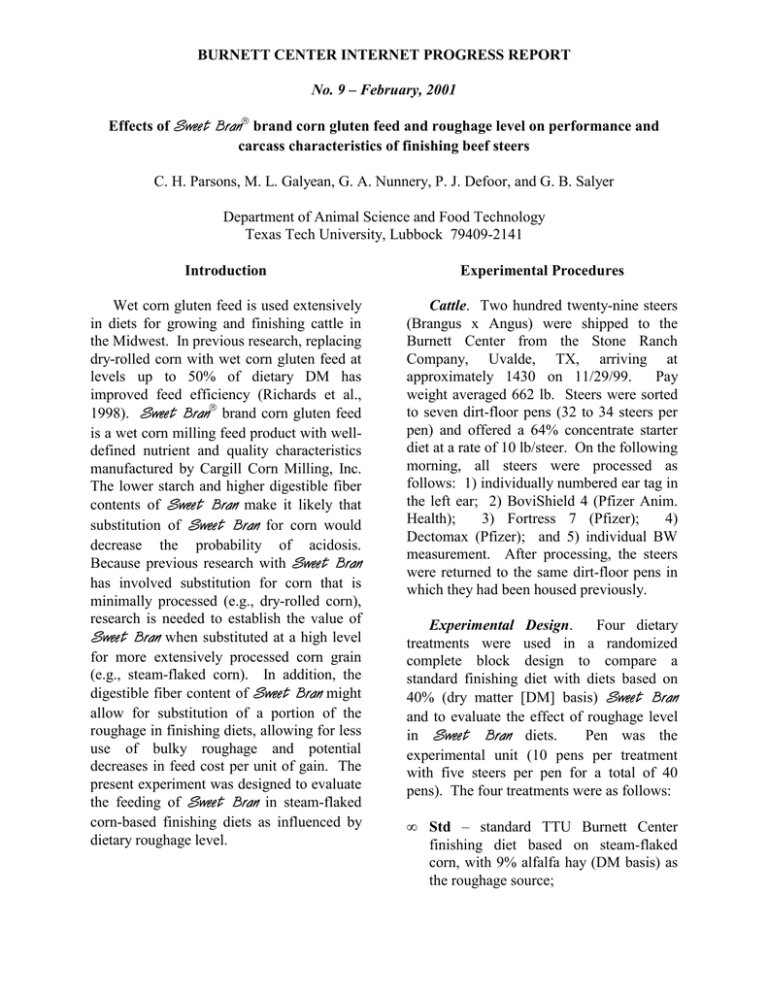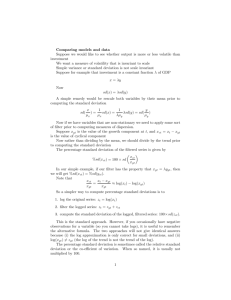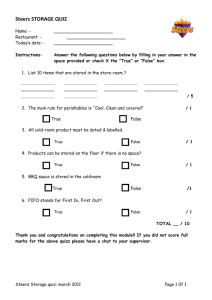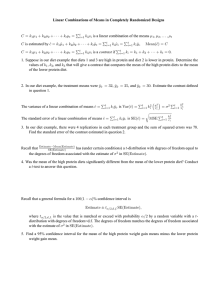BURNETT CENTER INTERNET PROGRESS REPORT Effects of
advertisement

BURNETT CENTER INTERNET PROGRESS REPORT No. 9 – February, 2001 Effects of 9]KKZ(XGT brand corn gluten feed and roughage level on performance and carcass characteristics of finishing beef steers C. H. Parsons, M. L. Galyean, G. A. Nunnery, P. J. Defoor, and G. B. Salyer Department of Animal Science and Food Technology Texas Tech University, Lubbock 79409-2141 Introduction Experimental Procedures Wet corn gluten feed is used extensively in diets for growing and finishing cattle in the Midwest. In previous research, replacing dry-rolled corn with wet corn gluten feed at levels up to 50% of dietary DM has improved feed efficiency (Richards et al., 1998). 9]KKZ(XGT brand corn gluten feed is a wet corn milling feed product with welldefined nutrient and quality characteristics manufactured by Cargill Corn Milling, Inc. The lower starch and higher digestible fiber contents of 9]KKZ (XGT make it likely that substitution of 9]KKZ (XGT for corn would decrease the probability of acidosis. Because previous research with 9]KKZ (XGT has involved substitution for corn that is minimally processed (e.g., dry-rolled corn), research is needed to establish the value of 9]KKZ(XGT when substituted at a high level for more extensively processed corn grain (e.g., steam-flaked corn). In addition, the digestible fiber content of 9]KKZ(XGT might allow for substitution of a portion of the roughage in finishing diets, allowing for less use of bulky roughage and potential decreases in feed cost per unit of gain. The present experiment was designed to evaluate the feeding of 9]KKZ (XGT in steam-flaked corn-based finishing diets as influenced by dietary roughage level. Cattle. Two hundred twenty-nine steers (Brangus x Angus) were shipped to the Burnett Center from the Stone Ranch Company, Uvalde, TX, arriving at approximately 1430 on 11/29/99. Pay weight averaged 662 lb. Steers were sorted to seven dirt-floor pens (32 to 34 steers per pen) and offered a 64% concentrate starter diet at a rate of 10 lb/steer. On the following morning, all steers were processed as follows: 1) individually numbered ear tag in the left ear; 2) BoviShield 4 (Pfizer Anim. Health); 3) Fortress 7 (Pfizer); 4) Dectomax (Pfizer); and 5) individual BW measurement. After processing, the steers were returned to the same dirt-floor pens in which they had been housed previously. Experimental Design. Four dietary treatments were used in a randomized complete block design to compare a standard finishing diet with diets based on 40% (dry matter [DM] basis) 9]KKZ (XGT and to evaluate the effect of roughage level in 9]KKZ (XGT diets. Pen was the experimental unit (10 pens per treatment with five steers per pen for a total of 40 pens). The four treatments were as follows: • Std – standard TTU Burnett Center finishing diet based on steam-flaked corn, with 9% alfalfa hay (DM basis) as the roughage source; • SB9 – steam-flaked corn-based finishing diet with 40% 9]KKZ (XGT (DM basis) and 9% alfalfa hay (DM basis) as the roughage source; • SB4.5 – steam-flaked corn-based finishing diet with 40% 9]KKZ(XGT (DM basis) and 4.5% alfalfa hay (DM basis) as the roughage source; • concentrate starter diet Finally, all cattle were weighed individually (beginning at 0700) to start the experiment on 12/14/99. Two 73% concentrate diets (Standard and 9]KKZ (XGT – described in the next section) were fed for the first time on this date. Experimental Diets. Ingredient composition of the diets fed during the experiment is shown in Table 1. These data reflect adjustments for the average DM content of feed ingredients for the period during which a given diet was fed. Cattle were gradually stepped through a series of diets varying in concentrate level to adapt them to the four treatment diets. All finishing diets were formulated to contain 14.4% CP. The Std diet was formulated to contain 0.63% Ca and 0.34% P, whereas the 9]KKZ(XGT diets were formulated to contain 0.68, 0.69, and 0.71% Ca and 0.66, 0.68, and 0.69% P, for the SB9, SB4.5, and SB0 diets, respectively. Each treatment diet contained a unique intermediate premix (Table 2) that supplied protein, various minerals and vitamins, Rumensin (30 g/ton, DM basis), and Tylan (8 g/ton, DM basis). SB0 – steam-flaked corn-based finishing diet with 40% 9]KKZ (XGT (DM basis) and 0% alfalfa hay (DM basis). All BW data and corresponding ear tag numbers were entered into a Microsoft Excel spreadsheet, and the data were sorted by BW. One steer died shortly after arrival, and nine steers were designated as Extra cattle because of either health problems or non-uniformity. Nineteen additional steers (the six heaviest steers and the 13 lightest steers of the remaining 219 steers) also were designated as Extra cattle. The BW data for the 200 selected steers were then sorted in ascending order, and groups of 20 steers, beginning with the 20 steers of lightest BW were assigned to 10 weight blocks. Within each block, steers were assigned randomly to one of four pens (five steers per pen). Blocks were then assigned to four contiguous pens in the Burnett Center, and within each group of four contiguous pens in a block, treatments were assigned randomly to pens. Management, Feeding, and Weighing Procedures. The four treatment diets were mixed in a 45-cubic foot capacity Marion paddle mixer. The Burnett Center feed milling system is operated by a computercontrolled WEM batching system. The daily use of each dietary ingredient was recorded by the computerized batching system. Once the total amount of feed for a given treatment was mixed, the mixed batch was released from the Marion paddle mixer and delivered by a drag-chain conveyer to a Rotomix 84-8 delivery system. The amount of feed allotted to each pen within treatment was then weighed to the nearest 2 lb by use of the load cells and indicator on the Rotomix 84-8 unit. Mixing and feeding On 12/7/99, the cattle were weighed and sorted to a new assigned dirt-floor pen based on blocks assignments. On 12/10/99, the cattle previously sorted by weight block groups on 12/7/99 were sorted to their assigned Burnett Center pens, and each steer was implanted with Ralgro (ScheringPlough Anim. Health) in the right ear. The cattle continued to be fed the 64% 2 order of treatment diets throughout the experiment was Std, SB9, SB4.5, and SB0. Clean out of the Rotomix 84-8 was monitored closely to avoid crosscontamination of diets. pen was recorded. This bunk-reading process was designed to allow for little or no accumulation of unconsumed feed (0 to 1 lb per pen). Feed bunks were cleaned, and unconsumed feed was weighed (Ohaus electronic scale, ± 0.1 lb) at intervals corresponding to intermediate weigh dates throughout the trial. Dry matter content of these bunk weighback samples was determined in a forced-air oven by drying overnight (typically 20 h) at 1000C. The DMI by each pen was calculated by multiplying the DM content of the delivered feed by the total feed delivery to each pen, with correction for the DM of feed weighed back from each pen. Dry matter determinations (forced-air oven for approximately 20 h at 1000C) on ingredients used in the experimental diets were made every 2 wk throughout the experiment, with the exception of 9]KKZ (XGT, for which DM was determined weekly. Ingredient DM values were used to calculate the DM percentage of each dietary ingredient during the experiment. In addition, samples of mixed feed delivered to feed bunks were taken weekly throughout the experiment and analyzed for DM content. These bunk sample DM values were used to compute average DM intake (DMI) by the cattle in each pen. In addition to forced-air oven-dried samples, weekly feed bunk samples were stored frozen until the end of each interval in which cattle were weighed (typically 28-d intervals), at which time they were composited by treatment and shipped to Cargill Corn Milling for analysis of DM content by vacuum drying procedures. These vacuum-oven DM values also were used to compute DMI for each pen of cattle. Forced-air oven-dried samples of feed taken from the bunk were composited to correspond with intervals in which cattle were weighed during the experiment. These samples were further composited to yield a single sample for each treatment diet, which was ground to pass a 2-mm screen in a Wiley mill and analyzed for DM, ash, CP, ADF, Ca, and P (AOAC, 1990; Table 3). After 28, 56, 84, 112, and 140 d on feed, steers in all pens were weighed individually (unshrunk) before the morning feeding. All BW measurements taken during the experiment were obtained using a singleanimal scale (C & S Single-Animal Squeeze Chute set on four load cells. The scale was calibrated with 1,000 lb of certified weights (Texas Dept. of Agriculture) on the day before each scheduled weigh day. These BW measurements were taken to assess performance of the cattle on a regular basis. On d 56, at the time of a regularly scheduled BW measurement, each steer was implanted with Revalor S (Intervet). The status of each implant was checked by palpation of the implant site at the time of the d-84 BW measurement. After the d-140 BW measurement, it was estimated that a majority of the steers in Blocks 4 though 10 would have sufficient finish to grade USDA Choice within approximately 2 wk. Hence, on 5/16/00 (d 154) steers in Blocks 4 through 10 were weighed and shipped to the Excel Corp. slaughter facility in Plainview, TX. Steers in Blocks 1 through 3 remained on feed until d 177 (6/8/00), at which time they were weighed and shipped to the Excel Each feed bunk of the 40 pens was evaluated visually at approximately 0700 to 0730 daily. The quantity of feed remaining in each bunk was estimated, and the suggested daily allotment of feed for each 3 Corp. slaughter facility in Plainview, TX. Of the original 200 steers that started the experiment, four steers had either died or had been removed from the experiment for reasons unrelated to treatment, resulting in a total of 196 steers being sent to the Excel Corp. facility. roughage level in 9]KKZ(XGT diets. Carcass quality grade data were analyzed by Chisquare procedures of SAS using individual animal data. Liver score data were not analyzed statistically because of the low number of observations in several of the categories. Carcass Evaluation. Personnel of the West Texas A&M University Beef Carcass Research Center obtained all carcass measurements. Liver abscess scores were recorded on a scale of 0 to 6, with 0 = no abscesses, 1 = A-, 2 = A, 3 = A+, 4 = telangiectasis, 5 = distoma (fluke damage), and 6 = fecal contamination that occurred at slaughter. Complete carcass data were obtained for all the 196 animals sent to the Excel Corp. facility in Plainview, TX. Results and Discussion Performance Data. Average composition of the experimental diets is shown in Table 3. Analyzed nutrient content was similar among the four treatment diets and generally in close agreement with formulated values. Crude protein content was slightly greater than expected from formulation, most likely because the CP value for steam-flaked corn used in formulation (8.5%) was less than the actual CP of the corn supply used during the experiment (9 to 9.5% based on samples collected during the experiment). Analyzed Ca content of the 9]KKZ (XGT diets was approximately 0.2 percentage units less than expected from formulation. As a result, the Ca:P ratios of SB diets were less than 1:1. The extent to which the lower than expected Ca was a result of an analytical failure to extract Ca from the three 9]KKZ(XGT diets or to mixing and(or) sampling problems is not known. Moreover, it is not clear to what extent a Ca:P ratio of less than 1:1 might affect performance by finishing beef cattle fed diets like those used in the present experiment. Statistical Analyses. All data were analyzed with pen as the experimental unit. A randomized complete block design was employed, and computations were made with the General Linear Models procedure of SAS (SAS Inst., Inc., Cary, NC). Pen means for daily gain and average daily DMI were included in the data file, and feed:gain ratio was computed as the quotient of daily DMI divided by daily gain. The effect of treatment and block were included in the model for pen-based data. Carcass data were entered on an individual animal basis and analyzed with a model that included effects of treatment, block, and block x treatment. Block x treatment was specified as the error term for testing treatment effects with carcass data. Residual mean square in this model for carcass data (not used for testing) included individual animal variation. The following orthogonal contrasts were used to test treatment effects: 1) Std diet vs the average of 9]KKZ (XGT diets; 2) linear effect of roughage level in 9]KKZ(XGT diets; and 3) quadratic effect of Initial BW (Table 4) did not differ among treatments, averaging 692 lb. Final BW did not differ between steers fed the Std diet and the average of steers fed 9]KKZ(XGT diets; however, within 9]KKZ (XGT diets, there was a linear (P < 0.02) increase in final BW with increasing roughage level. 4 Similarly, a linear effect (P < 0.02) of roughage level was noted for adjusted final BW (final BW based on hot carcass weight divided by the overall average dressing percent). A linear effect of roughage level on daily gain (P < 0.01) for the overall study was evident within the 9]KKZ (XGT diets, with greater gains by cattle fed the higher roughage levels. The difference in gain among roughage levels was most notable for the SB0 diet, with a decrease in daily gain of 6.5% compared with the SB9 diet. Cattle fed the SB0 diet had similar daily gain to cattle in the other three treatments until d 84 of the study, after which their gain decreased relative to the other treatments (data not shown). Carcass-adjusted gain for the overall study increased linearly (P < 0.01) as roughage level increased within the 9]KKZ (XGT diets. and DMI for the overall experiment calculated with these ingredient-based DM values is shown in Table 5. Using this approach, DMI was less (P < 0.05) by steers fed the Std diet than by the average of steers fed 9]KKZ(XGT diets, and a linear (P < 0.01) effect of roughage level within the 9]KKZ (XGT diets was evident. These results are very similar to those obtained with the previously discussed DMI values based on 1000C DM determinations of mixed feed samples (Table 4). If it is assumed that DMI is the best indicator of relative roughage value among diets, one should be able to estimate the roughage value of 9]KKZ (XGT relative to alfalfa. Based on data in Table 4, the overall DMI by steers fed the SB9 diet was 107.2% of steers fed the Std diet, and that by steers fed the SB4.5 diet was 104% of steers fed the Std diet. Intake by steers fed the SB0 diet was 98.6% of that by steers fed the Std diet, or essentially equal to a standard steamflaked corn diet with 9% alfalfa. Hence, based on DMI, the relative roughage value of 40% (DM basis) 9]KKZ (XGT should be .986 x 9% alfalfa or 8.9% alfalfa roughage equivalency. Obviously, this approach oversimplifies the concept of roughage and ignores ingredient composition differences among the diets. In addition, although DMI did not differ between the Std and SB0 diets, daily gain was less slightly less (3.3%) with SB0. Further research will be required to fully characterize the roughage equivalency of 9]KKZ(XGT. Daily DMI data based on DM determinations made at the Burnett Center using a 1000C forced-air oven are shown in Table 4. A linear effect (P < 0.01) of roughage level within the 9]KKZ (XGT diets was noted for DMI (Table 4). Moreover, daily DMI was approximately .5 lb per steer less (P < 0.05) with the Std diet vs the average of the 9]KKZ(XGT diets. Dietary DM content determined for feed bunk samples of the Std diet from vacuum oven measurements did not agree with values determined by 1000C oven drying. In addition, vacuum oven measurements of mixed diet samples did not agree with expected DM values calculated from ingredient DM content. As a result of these discrepancies, dietary DM values were reconstructed from ingredient DM determinations (1000C forced-air oven for all ingredients except 9]KKZ (XGT, which was determined by vacuum oven drying), Feed:gain ratio data for the study are shown in Tables 4 and 5. The feed:gain data in Table 4 are based on DMI calculated from DM determinations in a forced-air oven, whereas feed:gain data in Table 5 are based on DM determinations made by vacuum 5 drying of 9]KKZ (XGT samples. For the overall study, the feed:gain ratio based on forced-air oven DMI data (Table 4) was less (P < 0.04) for steers fed the Std diet than for the average of steers fed the 9]KKZ (XGT diets. In contrast, when feed:gain ratio (Table 4) was calculated on the basis of adjusted daily gain and forced-air ovenbased DMI, no differences (P > 0.10) were evident among treatments in feed:gain. Based on DM determinations made with a vacuum oven method (Table 5), feed:gain for the overall study was greater (P < 0.05) for the average of steers fed 9]KKZ(XGT diets than for those fed the Std diet; however, as with data in Table 4, carcass-adjusted feed:gain did not differ (P > 0.10) among treatments. Net Energy Calculations. Dietary NEm and NEg concentrations were calculated (NRC, 1996) from performance data. Calculated values for NEm and NEg were 2.33 and 1.63, 2.27 and 1.58, 2.29 and 1.60, and 2.30 and 1.61 Mcal/kg of DM for the Std, SB9, SB4.5, and SB0 diets, respectively. Although there was little difference in the NEm and NEg concentrations of the four diets, these values were considerably greater than the NRC (1996) tabular values (e.g., 2.18 and 1.50 Mcal/kg of DM for the Std diet). Zinn (1987) reported that the NEm and NEg concentrations of steam-flaked corn were 2.54 and 1.77 Mcal/kg, respectively, and Ward et al. (2000) reported values of 2.49 and 1.77 Mcal/kg, for NEm and NEg, repectively, for steam-flaked corn. If one assumes tabular values of 2.53 and 1.80 Mcal/kg for the NEm and NEg, respectively, for steam-flaked corn in the present study, tabular values match the values calculated from performance data. Assuming values of 2.33 and 1.63 for the NEm and NEg, respectively, of the Std diet, an iterative process was used to calculate the NEm and NEg values of 9]KKZ (XGT that would be required to yield the performance-based net energy values. Resulting NEm and NEg values for 9]KKZ (XGT were 2.12 and 1.46, 2.06 and 1.41, and 1.98 and 1.33 Mcal/kg of DM for the SB9, SB4.5, and SB0 diets, respectively. It is unlikely that differences in the status of the Revalor S implants given on d 56 affected performance by the steers in this study. Only one (1) missing implant was detected among the 197 steers evaluated. Implant abnormalities determined by palpation of the implant site 28 d after the implant was given (d 84) averaged 14.2% across treatments and are shown in the following table. Item No abnormality Abscess with pellets Implant in cartilage Implant separated Implant missing Crushed pellets TOTAL ANIMALS Treatment Std SB9 SB4.5 SB0 43 39 42 45 4 3 3 3 1 2 2 0 1 0 0 4 0 0 2 1 0 1 0 1 49 48 50 50 Carcass Data. Carcass data are shown in Table 6. Few differences were noted among treatments. Carcasses of steers fed the Std diet did not differ (P > 0.10) for any carcass measurement compared with the average of carcasses from steers fed the three 9]KKZ(XGT diets. A linear effect (P < 0.01) of roughage level within the 9]KKZ (XGT diets was detected for hot carcass weight, which would be expected from the 6 linear increase in daily gain (Tables 4 and 5) noted previously. A quadratic effect (P < 0.05) was observed for dressing percent among 9]KKZ(XGT diets, with an increase in dressing percent noted with the SB4.5 diets relative to the SB9 and SB0 diets. There was a tendency (linear effect, P < 0.10) for cattle fed the higher roughage levels within the 9]KKZ (XGT diets to have larger longissimus muscle areas, which might reflect the linear increase in ADG with increasing roughage level. Quadratic responses (P < 0.03) to roughage level within 9]KKZ (XGT diets were noted for fat thickness and yield grade, with higher values for the SB4.5 diet. These increases in fat thickness and yield grade parallel the increased dressing percent noted for carcasses of steers fed SB4.5. Angus steers used in this study were on feed for 154 to 177 d. Daily gain (live and carcass-adjusted) and carcass-adjusted feed:gain of steers fed the steam-flaked standard finishing diet did not differ from the average of the steers fed the 9]KKZ(XGT diets. Under these conditions, the estimated NEg concentration of 9]KKZ (XGT was approximately 80% that of steam-flaked corn, although the NEg concentration of the three diets containing 40% 9]KKZ (XGT averaged approximately 98% of the steamflaked corn-based standard finishing diet. Adding roughage to 9]KKZ (XGT diets increased daily gain, dry matter intake, and hot carcass weight. Diets containing 9]KKZ (XGT did not have any major effects on carcass characteristics compared with a standard finishing diet. Select and Standard grades were pooled for this analysis because of the small number of Standard carcasses. The distribution of Choice vs Select + Standard USDA quality grades (Table 6) was not affected by treatment (P > 0.51). Literature Cited AOAC. 1990. Official Methods of Analysis (15th ed.). Association of Official Analytical Chemists. Washington, DC. Liver score data (data not shown) were not analyzed statistically because of the low or missing frequency of observations in certain categories, which would result in a potentially invalid Chi-Square analysis. No major differences were noted in liver score categories among treatments. Six percent or less of the steers actually had abscessed livers, with most of the liver condemnations being the result of other causes. NRC. 1996. Nutrient Requirements of Beef Cattle (7th ed.). National Academy Press, Washington, DC. Richards, C. J., R. A. Stock, T. J. Klopfenstein, and D. H. Shain. 1998. Effect of wet corn gluten feed, supplemental protein, and tallow on steer finishing performance. J. Anim. Sci. 74:421-428. Summary and Conclusions Diets with 40% 9]KKZ (XGT and 0, 4.5, or 9% alfalfa hay on a dry matter basis were compared with a standard finishing diet (steam-flaked corn base with 9% alfalfa hay) in a growing/finishing study. The Brangus x 7 Ward, C. F., M. L. Galyean, P. J. Defoor, G. A. Nunnery, G. B. Salyer, H. M. Derington, and C. H. Parsons. 2000. Effects of SarStart DSC on performance and carcass characteristics of finishing beef steers fed dry-rolled or steam-flaked corn diets. Burnett Center Internet Progress Report No. 5. http://www.asft.ttu.edu/burnett_cente r/progress_reports. Acknowledgements This experiment was supported, in part, by a grant from Cargill Corn Milling, Inc., Blair, NE. The authors thank Kirk Robinson (Burnett Center Manager), Ricardo Rocha (Burnett Center Assistant Manager), and Chris Ward (Burnett Center Technician) for their assistance with the experiment. Zinn, R. A. 1987. Influence of lasalocid and monensin plus tylosin on comparative feeding value of steamflaked versus dry-rolled corn in diets for feedlot cattle. J. Anim. Sci. 65:256-266. 8 Table 1. Ingredient composition (%, DM basis) of the experimental dietsa Percentage of dietary concentrate 73 82 91 100 SB4.5 SB0 Ingredient Std SB Std SB Std Alfalfa hay, ground 9.03 9.16 9.14 9.19 9.13 9.17 4.54 - Cottonseed hulls 18.32 18.43 9.15 9.18 - - - - Steam-flaked corn 53.76 28.22 63.85 36.57 73.86 SB9 95.5 45.38 48.97 52.29 39.78 39.75 39.77 9]KKZ(XGT - Cottonseed meal 9.52 - 7.75 - 6.12 - 1.17 2.34 Molasses 4.21 - 4.17 - 4.25 - - - Fat (yellow grease) 2.04 2.16 2.55 2.60 3.01 3.15 3.02 3.03 Urea 0.58 - 0.83 - 1.11 - - - Premixb 2.54 2.50 2.56 2.51 2.52 2.52 2.55 2.57 39.53 - 39.95 - Std = standard TTU Burnett Center diet; SB = 9]KKZ(XGT; SB9 = 9]KKZ(XGT diet with 9% (DM basis) alfalfa hay; SB4.5 = 9]KKZ (XGT diet with 4.5% (DM basis) alfalfa hay; and SB0 = 9]KKZ(XGT diet with no added roughage. a b Composition of the four treatment premixes is shown in Table 2. 9 Table 2. Composition (%, DM basis) of the premixes used in experimental diets Treatmenta Ingredient Cottonseed meal Ground milo Limestone Dicalcium phosphate Potassium chloride Magnesium oxide Ammonium sulfate Salt Cobalt carbonate Copper sulfate SQM copperb Iron sulfate EDDI Manganese oxide Selenium premix, .2% Se Zinc sulfate Vitamin A, 650,000 IU/gc Vitamin E, 275 IU/gc Rumensin, 80 mg/lbc Tylan, 40 mg/lbc Std 23.9733 42.1053 1.0363 8.0000 3.5587 6.6667 12.0000 .0017 .1572 .1333 .0025 .2667 .1000 .8251 .0122 .1260 .6750 .3600 SB9 SB4.5 SB0 28.2363 52.6316 3.5587 12.0000 .0017 1.0709 .1333 .0025 .2667 .1000 .8251 .0122 .1260 .6750 .3600 20.3416 60.5263 3.5587 12.0000 .0017 1.0709 .1333 .0025 .2667 .1000 .8251 .0122 .1260 .6750 .3600 12.4468 68.4211 3.5587 12.0000 .0017 1.0709 .1333 .0025 .2667 .1000 .8251 .0122 .1260 .6750 .3600 Std = standard TTU Burnett Center diet; SB9 = 9]KKZ (XGT diet with 9% (DM basis) alfalfa hay; SB4.5 = 9]KKZ(XGT diet with 4.5% (DM basis) alfalfa hay; and SB0 = 9]KKZ(XGT diet with no added roughage. a b c Quali Tech, Inc., Chaska, MN (SQM Cu is a polysaccharide complex of Cu). Concentrations noted by the ingredient are on a 90% DM basis. 10 Table 3. Chemical composition of the experimental dietsa Percentage of dietary concentrate 73 Ingredient 82 91 95.5 100 Std SB Std SB Std SB9 SB4.5 SB0 81.77 69.74 81.45 70.99 81.76 70.76 70.18 70.15 5.21 6.31 4.90 7.01 4.95 5.63 5.74 5.35 Crude protein, % 13.46 13.63 15.09 14.98 14.65 14.39 14.67 14.84 ADF, %c 17.94 17.36 12.82 16.01 7.37 8.87 7.13 5.01 Calcium, % 0.69 0.60 0.71 0.83 0.74 0.50 0.54 0.53 Phosphorus, % 0.31 0.58 0.31 0.62 0.34 0.61 0.64 0.66 Dry matter, %b Ash, % Std = standard TTU Burnett Center diet; SB9 = 9]KKZ(XGT diet with 9% (DM basis) alfalfa hay; SB4.5 = 9]KKZ(XGT diet with 4.5% (DM basis) alfalfa hay; and SB0 = 9]KKZ(XGT diet with no added roughage. a b c All values except Dry matter, % are expressed on a DM basis. ADF = Acid detergent fiber. 11 Table 4. Effects of a steam-flaked corn-based diet with 9% (DM basis) alfalfa hay and diets with 40% (DM basis) 9]KKZ(XGT plus 0, 4.5, or 9% (DM basis) alfalfa hay on performance by finishing beef steers – DM values based on forced-air oven drying Treatmenta Item Initial BW, lb Final BW, lb Adjusted final BW, lbd Daily gain, lbe Adjusted daily gain, lbd Daily DMI, lb/steere Feed:gaine Adjusted feed:gaind Std SB9 692.5 1,221.3 1,220.6 690.7 1,238.9 1,239.5 3.30 3.29 16.02 4.87 4.88 3.41 3.41 17.17 5.04 5.04 Contrastc SB4.5 693.8 1,228.0 1,235.8 3.33 3.38 16.66 5.01 4.95 SB0 691.7 1,203.9 1,197.4 3.19 3.14 15.80 4.96 5.03 SEb Std vs SB L Q 2.87 9.98 10.99 NS NS NS NS .02 .02 NS NS NS NS NS .05 .04 NS .01 .01 .01 NS NS NS NS NS NS NS 0.055 0.063 0.214 0.053 0.069 Std = standard TTU Burnett Center diet; SB9 = 9]KKZ(XGT diet with 9% (DM basis) alfalfa hay; SB4.5 = 9]KKZ(XGTdiet with 4.5% (DM basis) alfalfa hay; and SB0 = 9]KKZ(XGT diet with no added roughage. a b c Pooled standard error of main-effect means, n = 10 pens per treatment. Observed significance level for orthogonal contrasts. NS = not significant, P > 0.10. d Adjusted final BW was calculated as follows: (Hot carcass weight/average dress of 63.13%). Adjusted daily gain was calculated as follows: (Adjusted final BW – initial BW)/days on feed. Adjusted feed:gain was the ratio of daily DMI and adjusted daily gain. e Cattle in Blocks 4 through 10 were on feed for 154 d, whereas cattle in Blocks 1 through 3 were on feed for 177 d. 12 Table 5. Effects of a steam-flaked corn-based diet with 9% (DM basis) alfalfa hay and diets with 40% (DM basis) 9]KKZ(XGT plus 0, 4.5, or 9% (DM basis) alfalfa hay on overall performance by finishing beef steers – DM values based on vacuum oven drying of 9]KKZ(XGT Treatmenta Item Initial BW, lb Final BW, lb Adjusted final BW, lbd Daily gain, lbe Adjusted daily gaind Daily DMI, lb/steer Feed:gain Adjusted feed:gaind Std SB9 692.5 1,221.3 1,220.6 690.7 1,238.9 1,239.5 3.30 3.29 16.13 4.90 4.91 3.41 3.41 17.19 5.04 5.05 Contrastc SB4.5 693.8 1,228.0 1,235.8 3.33 3.38 16.85 5.06 5.00 SB0 691.7 1,203.9 1,197.4 3.19 3.14 15.95 5.00 5.08 SEb Std vs SB L Q 2.87 9.98 10.99 NS NS NS NS .02 .02 NS NS NS NS NS .05 .05 NS .01 .01 .01 NS NS NS NS NS NS NS 0.055 0.063 0.220 0.055 0.071 Std = standard TTU Burnett Center diet; SB9 = 9]KKZ(XGT diet with 9% (DM basis) alfalfa hay; SB4.5 = 9]KKZ(XGT diet with 4.5% (DM basis) alfalfa hay; and SB0 = 9]KKZ(XGT diet with no added roughage. a b c Pooled standard error of main-effect means, n = 10 pens per treatment. Observed significance level for orthogonal contrasts. NS = not significant, P > 0.10. d Adjusted final BW was calculated as follows: (Hot carcass weight/average dress of 63.13%). Adjusted daily gain was calculated as follows: (Adjusted final BW – initial BW)/days on feed. Adjusted feed:gain was the ratio of daily DMI and adjusted daily gain. e Cattle in Blocks 4 through 10 were on feed for 154 d, whereas cattle in Blocks 1 through 3 were on feed for 177 d. 13 Table 6. Effects of a steam-flaked corn-based diet with 9% (DM basis) alfalfa hay and diets with 40% (DM basis) 9]KKZ(XGT plus 0, 4.5, or 9% (DM basis) alfalfa hay on carcass characteristics of finishing beef steers Treatmenta Item Hot carcass wt, lb Dressing percent LM area, sq. in.d Fat thickness, in. KPH, %e Yield grade Marbling scoref Choice, %g Select, % Standard, % Contrastc Std SB9 SB4.5 SB0 770.6 63.11 12.59 0.55 1.99 3.17 402.6 44.90 55.10 0.00 782.5 63.16 12.95 0.56 1.95 3.11 388.5 45.83 47.92 6.25 780.2 63.53 12.56 0.60 1.96 3.33 411.2 53.06 46.94 0.00 755.9 62.78 12.57 0.51 1.93 3.03 393.0 38.00 52.00 10.00 SEb 6.94 0.221 0.160 0.023 0.043 0.091 12.10 - Std vs SB L Q NS NS NS NS NS NS NS - .01 NS .10 NS NS NS NS - NS .05 NS .03 NS .03 NS - Std = standard TTU Burnett Center diet; SB9 = 9]KKZ(XGT diet with 9% (DM basis) alfalfa hay; SB4.5 = 9]KKZ(XGT diet with 4.5% (DM basis) alfalfa hay; and SB0 = 9]KKZ(XGT diet with no added roughage. a b c Pooled standard error of main-effect means, n = 10 pens per treatment. Observed significance level for orthogonal contrasts. NS = not significant, P > 0.10. d LM = longissimus muscle. e KPH = kidney, pelvic, and heart fat. f 300 = Slight0; 400 = Small0; 500 = Modest0. g Distribution of Choice and Select + Standard carcasses did not differ among treatments (P > 0.51). 14






